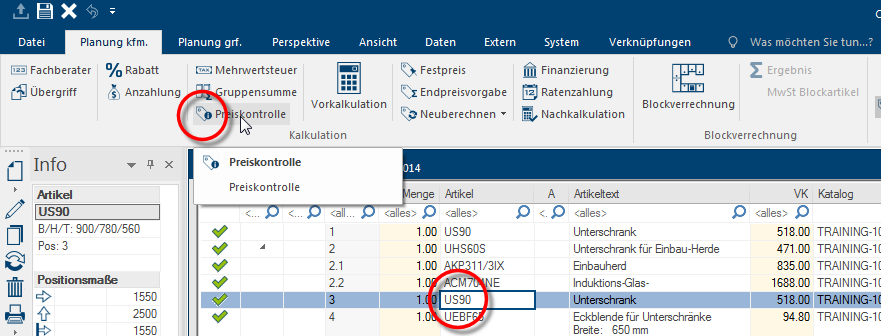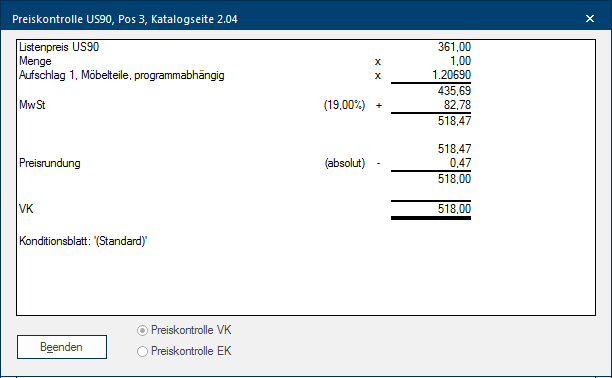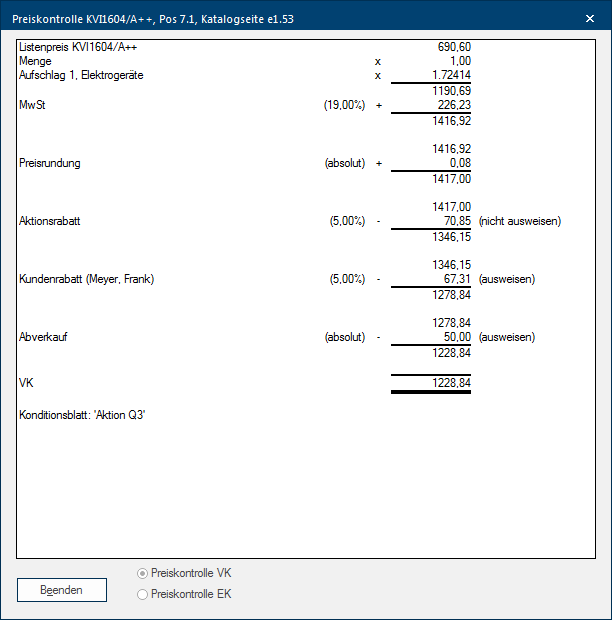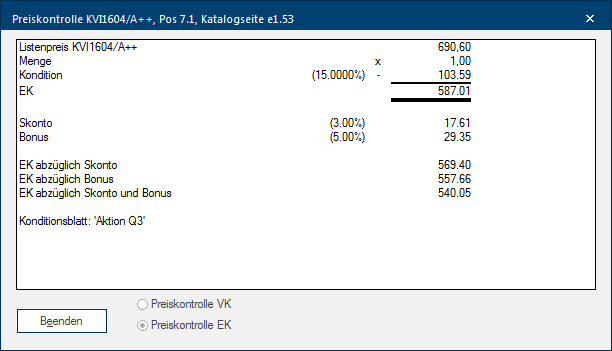The Price control

With the Price control, dialogue Dialogue, dialogue windows or dialogue fields are special windows in software applications. Dialogue windows are displayed by application programs in different situations to request input or confirmation from the user. you are provided with a tool with which you can check the price calculation of a single article easily. Based on the list price The list price in CARAT designates the price that was deposited by the manufacturer in the CARAT catalogue data., all steps necessary to calculate the price of the selected articles are listed. The price control dialogue can show the calculation for the selling price as well as for the purchase price.
To open the price control, please first mark the article required, preferably in the parts list. The position line of the article is then accentuated in bleu-grey. Click Typically the LEFT mouse button is pressed once quickly, if not specified differently. Clicking will either mark an object, or when clicking on a button, the execution of the desired activity (e.g. OK, Cancel, Close). subsequently on the option The word option (from Latin: optio = free will) used in computing means a choice. In CARAT it is normally used with a list box. Price control on the Planning comm. index card Some dialogue windows are too voluminous, therefore the functions are separated into indexed groups. The subgroup names typically appear on the tab of the index card at the top of the dialogue and can be selected by clicking on the appropriate tab. in the menu ribbon.
If the user has the appropriate right to view the price calculation, the Price control dialogue can be switched between SP The SP (selling price) in CARAT is a result of multiplying the CARAT list price by the entered net surcharge factor, plus VAT. and PP The PP (purchase price) in CARAT, refers to the price less conditions but before designated cash discounts and bonus.. As standard is by opening the SP-calculation always retrieved first, as you can see in the following picture.
The computation shown in the Price control dialogue complies with the price calculation in CARAT and always follows the same sequence. The list price is multiplied Multiplication (from Latin: multiplicare = multiply, also know as times) is one of four basic operations in arithmetic. by the quantity and the net-surcharge. Subsequently is the VAT added Addition (in Latin: addere) is one of four basic operations in arithmetic. In primary school and in common language it is the expression used for the adding of two or more numbers. and the calculated selling price rounded, if price rounding is activated. You can also recognize which condition page On a conditions page is the calculation data for all calculation groups and condition schemes entered. The condition page "standard" should always be used for the base calculation. You can however, create more condition pages in order to implement special requirements. is used as basis for the price control and on which surcharge from this condition page is drawn upon for the price calculation.
If you have assigned discounts, these will also be listed individually in the Price control dialogue. From the position in the calculation example you can recognize which discounts are deducted when and if it is an absolute or percentual discount. Additionally Addition (in Latin: addere) is one of four basic operations in arithmetic. In primary school and in common language it is the expression used for the adding of two or more numbers. you can recognize if a discount should be displayed in a quotation. In a quotation, your customers are only shown discounts with the option Show. Discounts with the option Do not show only reduce the article price but are not specified separately.
You can access the price control for the PP, to view the calculation of the purchase price. Also here complies the computation shown in the Price control dialogue with the price calculation in CARAT and follows always the same sequence. The list price is multiplied by the quantity and the condition is subsequently subtracted The subtraction (also called minus-calculation) is the withdrawal of one number from another. Subtraction is one of the basic operations of arithmetic. The opposite of subtraction is addition. The sign for subtraction is the minus sign „−“.. If cash discount and bonus are deposited, the therefrom resulting PP is listed separately. Here is of course also the condition page which is the basis for the values displayed.






